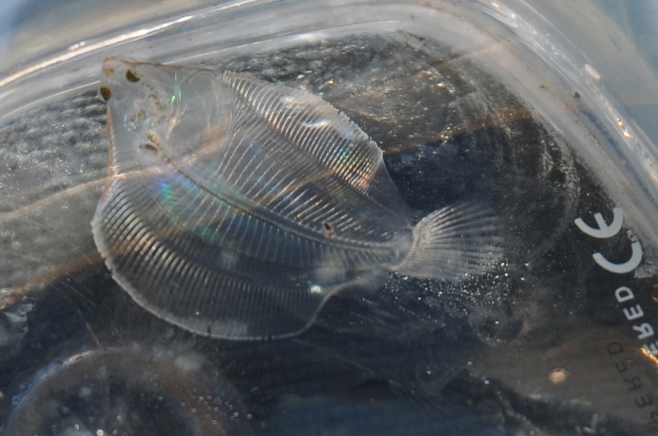What’s With the Flat Face?
Seadate April 11th, 2020, Port McNeill.
Suddenly I realized the bottom of the Ocean was staring at me.
It has happened before and . . . oh how I stared back!

These flatfish or flounders are a particular marvel.
In this case, the species of flounder was a big Rock Sole (Lepidopsetta bilineata up to 58 cm long).

Be sure to read below about the “ba-boing” of their eyes! Yes, I am a scientist but that may not be a fully appreciated scientific descriptor. 🙂

Rock Sole are a “righteye flounder” species. All flounder species start off, when larvae, with eyes on either side of their heads. They are anything but “floundering”. They are astounding adapted for life on the sand. (I include photos of additional NE Pacific flatfish species at the end of this blog).
As the larvae develop, the right or left eye (depending on species) migrates across the top of the head to the other side of the body changing some skull bones in the process. This adaptation “allows flatfish to exploit a common habitat – flat sandy bottoms . . . Many fish avoid this habitat because of the lack of rocks or other features that would provide a hiding place. Flatfish can hide from predators by burrowing [and/or camouflaging], leaving only their eyes above the surface . . . the habitat is home to an abundance of prey such as worms and shrimp. With both eyes on the upper side they can use 3D vision to hunt and detect predators. There has been considerable controversy over the origin of flatfish, but recent discoveries of several fossil intermediate forms show that eye migration evolved gradually some fifty million years ago.” Source: Puget Sound Sea Life.
The series of photos show this metamorphosis (images by Dr. Alexander M. Schreiber):
Also, flatfish change colour to match their surroundings. But how is this possible when their eyes are positioned where they are?
The answer via National Geographic: “All flatfish have eyes on the end of stalks, so they pop out of the head “kind of like the eyes we saw in cartoons—ba-boing!” says George Burgess of the Florida Museum of Natural History. Thanks to those pop-up peepers, “they can’t see the bottom directly underneath them, but they can see the bottom around them,” notes Jackie Cooper of the National Aquarium in Baltimore. Once flatfish eyes get the lay of the land, they message the brain, which in turn sends signals back to the skin. This organ contains color-changing cells such as melanophores, which either expand or contract according to the background the fish is trying to match . ..”
At this time where so many are striving to educate children at home, I want for my blogs like this to be of all the more use. For example, I am hoping the photos allow for children to reflect “if the fish looks like this, what advantages does that provide” , leading to greater deductive reasoning, connection to life in dark seas, and ultimately the appreciation that organisms are the way they are for a reason i.e. the understanding of adaptations.
More fabulous flatfish faces below.
(Note that this NOT a comprehensive showing of ALL the flatfish / flounders of the NE Pacific Ocean. Rather, it’s just some of the species I have had the opportunity to photograph.
Some Lefteye Flounder Species
Now more commonly called the “Sand Flounders”
Family Paralichthyidae:

Pacific Sanddab (Citharichthys sordidus to 41 cm).

Speckled Sanddab (Citharichthys stigmaeus to 17 cm). This one is only about 5 cm long. At first I thought it was an Alder leaf.
Other Righteye Flounder Species
Family Pleuronectidae:

Sand Sole (Psettichthys melanostictus to 63 cm). This little one was only ~2.7 cm. I found this little guy/ gal in a tideline and photographed it in my dive mask. See the blog I wrote about this “find” in my “Plankton Got Sole” item at this link.

C-O Sole (Pleuronichthys coenosus to 36 cm). This one has more pink colouration than usual as it is living around pink coralline algae. Named the “C-O” Sole for the reverse “C” and an “O” shape on the tail.


Another C-O Sole to give a sense of the variation in colour. A big dot in the middle of the body is typical in this species. For this individual, you will note it is purple.
 Curlfin Sole (Pleuronichthys decurrens to 37 cm)
Curlfin Sole (Pleuronichthys decurrens to 37 cm)
And more Rock Sole photos because you can never have enough:



Note that the tube worm species here is believed to be an invasive – Chaetopteridae or Spionidae (as shared by expert Leslie Harris).



Same individual as above photo.
Sources:
-
- Jamison, David; Sand Sole; Puget Sound Sea Life
- Jensen, Greg; Flatfish Made Easy (free e-book)
- Ichthyoplankton Information System – planktonic life stages of fish in the northeast Pacific
- Langley, Liz; August 13, 2016; Flounders’ Eyes Face Skyward. How Do They See the Ocean Floor?; National Geographic
- Lamb, Andy and Edgell, Phil. 2010. Coastal Fishes of the Pacific Northwest
- Schreiber, Alexander. (2013). Flatfish: An Asymmetric Perspective on Metamorphosis. Current topics in developmental biology. 103. 167-94. 10.1016/B978-0-12-385979-2.00006-X

